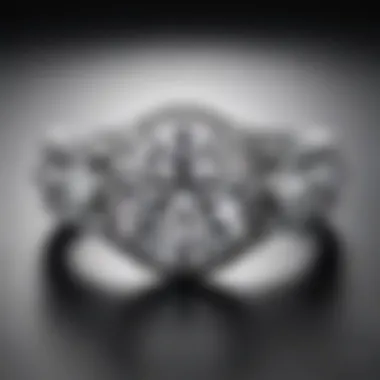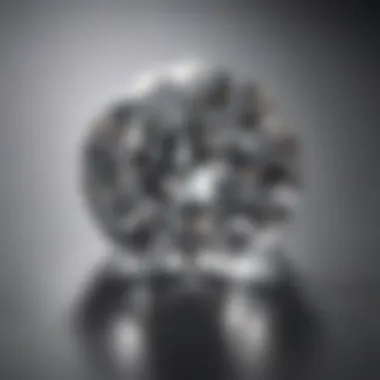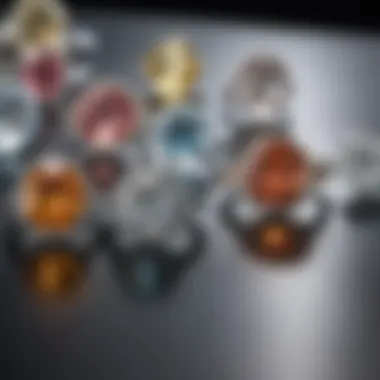Custom Lab Grown Diamond Engagement Rings: An In-Depth Look


Intro
In recent years, the engagement ring market has seen significant changes, especially with the adoption of custom lab-grown diamonds. These diamonds are not merely alternatives; they represent a shift in consumer preferences, focusing on sustainability, ethics, and personalization. The intricate journey of crafting a lab-grown diamond engagement ring offers consumers a wealth of options, alongside a deeper understanding of the materials they choose. By exploring the nature of gemstones and their influence on jewelry choices, we can appreciate the value of custom lab-grown diamond engagement rings.
Overview of Gemstones and Minerals
Gemstones and minerals have long fascinated individuals, shaping cultural practices and societal norms throughout history. Engagement rings, in particular, have a storied past linked to traditions and values. The use of gemstones in adornments can be traced back thousands of years, capturing the essence of beauty and status.
- History of Gemstone and Mineral Use
Gemstones like diamonds, emeralds, and sapphires have adorned royal families and significant figures throughout history, signifying wealth, power, and love. In the past, these stones were often sourced from remote locations, emphasizing the rarity and desirability of the gems. - Significance in Culture and Society
Culturally, gemstones often bear meanings and symbolism. For instance, diamonds symbolize eternal love, making them a popular choice for engagement rings. The significance placed on gemstones varies greatly across different cultures, contributing to their allure and mystique.
Gemstone Formation and Properties
Understanding how gemstones form provides insight into their unique properties. This knowledge is crucial in appreciating lab-grown diamonds, which mimic natural processes but are created in controlled environments.
- Formation Process of Gemstones
Natural diamonds are formed deep within the Earth's mantle under immense pressure and heat over millions of years. Conversely, lab-grown diamonds are produced through two primary methods: High Pressure High Temperature (HPHT) and Chemical Vapor Deposition (CVD). Both methods replicate the natural conditions, resulting in diamonds that are chemically identical to their mined counterparts. - Properties that Define Gemstones
Gemstones possess distinct characteristics that define their quality and desirability. These properties include clarity, color, carat weight, and cut. Lab-grown diamonds exhibit the same properties, allowing for customization in design and appearance. - Classification Based on Color, Hardness, and Luster
Gemstones are classified based on their color, with diamonds available in various hues. Hardness is determined by the Mohs scale, where diamonds rank the highest at ten, indicating their durability. Luster describes how light interacts with the surface of the gemstone, enhancing its visual appeal.
Types of Gemstones
Knowing the different types of gemstones available is essential for making an informed choice. Understanding these categories helps individuals appreciate the unique qualities that each type of stone offers.
- Precious vs. Semi-Precious Gemstones
Traditionally, four gemstones - diamonds, rubies, sapphires, and emeralds - are categorized as precious, while others like amethyst and garnet fall under semi-precious. Lab-grown diamonds typically belong to the precious category. - Common Gemstone Varieties
Common gemstones used in engagement rings include diamonds, sapphires, emeralds, and moissanite. Each stone has its own distinct characteristics, appealing to diverse tastes. - Exotic and Rare Gemstones
For those looking for uniqueness, exotic and rare gemstones such as tanzanite or alexandrite offer an intriguing alternative. However, these stones may require additional knowledge regarding sources and care.
Identifying and Evaluating Gemstones
When considering gemstones, particularly in the context of engagement rings, consumers should understand how to identify and evaluate them. This assessment can influence both aesthetic choices and investment value.
- Factors Affecting Gemstone Value
Value is influenced by rarity, quality, size, and demand. Lab-grown diamonds usually cost less than natural diamonds, making them an appealing choice for many. - Techniques for Gemstone Identification
Various tools and techniques can be employed to identify gemstones accurately. These include gemological microscopes and refractometers, allowing jewelers to assess specific characteristics. - Assessing Gemstone Quality
Quality assessments often rely on the four Cs: cut, color, clarity, and carat weight. This framework assists consumers in making informed decisions when selecting an engagement ring.
Caring for Gemstones
Proper care of gemstones is integral to maintaining their beauty and longevity. Understanding how to clean and store them helps preserve their charm over time.
- Cleaning and Storing Gemstones Properly
It is essential to clean gems safely, using mild soap and water. Storing them separately reduces the risk of scratches and damage. - Avoiding Common Mistakes in Gemstone Care
Common mistakes include exposing gems to harsh chemicals or extreme temperatures, which can compromise their quality. - Preservation Tips for Specific Gem Types
Different gemstones may require tailored care. For example, softer stones like opals need more careful handling than harder stones like diamonds or sapphires.
By delving into each of these topics, it becomes clear that custom lab-grown diamond engagement rings represent a progressive choice amid the larger conversation surrounding gemstones and societal values surrounding engagement and love.
Preamble to Lab Grown Diamonds
The discussion around lab grown diamonds has gained significant momentum in recent years. This section serves as a gateway into understanding these gems, shedding light on their definition and how they compare to their natural counterparts.
By examining lab grown diamonds, we recognize their implications for consumers, jewelers, and the environment. As sustainable practices take center stage in modern jewelry, understanding the basics of lab grown diamonds helps inform choices that align with ethical values and design preferences.
Defining Lab Grown Diamonds
Lab grown diamonds, also known as synthetic or cultured diamonds, are diamonds that are created in controlled environments using advanced technological processes. Unlike natural diamonds, which form over millions of years deep within the Earth, these diamonds can be produced in a matter of weeks. They share the same physical, chemical, and optical properties as natural diamonds, placing them in the same category, yet their origin is significantly different.
The two primary methods for creating lab grown diamonds are the High Pressure High Temperature (HPHT) method and Chemical Vapor Deposition (CVD). Each method reflects a unique approach to diamond synthesis, ultimately resulting in products that are indistinguishable from naturally occurring diamonds by the naked eye. In many cases, gemological tools are required to identify the specific origin of the diamond.
Comparison with Natural Diamonds
When comparing lab grown diamonds to natural diamonds, several factors merit attention.
- Cost: Lab grown diamonds often have a lower price point. They can cost up to 40% less than natural diamonds of comparable quality. This makes them an attractive option for budgets, particularly for engagement rings.
- Sustainability: Producing lab grown diamonds produces less environmental destruction compared to mining natural diamonds. This appeal resonates with environmentally conscious consumers.
- Ethical Considerations: The mining of natural diamonds has been associated with various ethical issues, including labor exploitation and funding conflicts. Lab grown diamonds eliminate these concerns since they are created in a controlled setting.
- Rarity and Perception: Natural diamonds are considered rarer and often carry sentimental value connected to their geological history. In contrast, lab grown diamonds, while identical in quality, lack this natural scarcity, which may influence some consumers' perceptions.
"Understanding the fundamental differences between lab grown and natural diamonds is crucial for consumers making informed purchases in the gemstone market."
When evaluating lab grown diamonds, one must consider these distinctions carefully. As consumer attitudes evolve, these diamonds may reshape the landscape of the jewelry market, marking a shift towards more sustainable and ethical choices.
The Science Behind Lab Grown Diamonds
Understanding the science behind lab grown diamonds is essential for anyone interested in custom engagement rings. This knowledge provides insights into how these diamonds are made, their properties, and what distinguishes them from their natural counterparts. The two primary methods of creating lab grown diamonds are High Pressure High Temperature (HPHT) and Chemical Vapor Deposition (CVD). Both methods have unique characteristics that influence the final product in terms of quality and appearance. Acknowledging these aspects can enhance the overall appreciation of lab grown diamonds.


The Creation Process
Lab grown diamonds are not simply replicas of natural diamonds; they are real diamonds with identical chemical structures. The creation process involves advanced scientific techniques, ensuring their authenticity and appeal.
High Pressure High Temperature (HPHT)
High Pressure High Temperature is one of the earliest methods used to create laboratory diamonds. This method mimics the natural process that occurs in the Earth's mantle. HPHT involves applying extreme temperatures and pressures to carbon sources, generally graphite. The key characteristic of this method is its ability to produce diamonds that are often identical in composition to natural diamonds.
A notable feature of HPHT diamonds is the growth of crystal structure. This process can take several weeks, resulting in high-quality stones with unique characteristics. This method is often preferred when one seeks substantial quality and brilliance. The main advantage of HPHT is its ability to create diamonds with fewer impurities and inclusions, enhancing their clarity. However, this process can be complex, requiring significant technological investment.
Chemical Vapor Deposition ()
Chemical Vapor Deposition is a more modern technique that has gained popularity in recent years. CVD diamonds are created by introducing gases into a chamber, where they are ionized to form carbon atoms. These atoms then deposit onto a substrate, gradually building a diamond structure. The key characteristic of CVD is its versatility, allowing for precise control over the diamond’s traits based on varying process conditions.
A unique feature of CVD diamonds is their ability to be customized to some extent during growth, leading to specific color variations. For those seeking specific visual effects, CVD is a beneficial choice. Additionally, CVD diamonds can be produced more rapidly than HPHT diamonds, often leading to cost savings. However, some may argue that the consistency of quality can vary based on the specific conditions during production.
Gemological Properties
The gemological properties of lab grown diamonds play a crucial role in their appeal. These attributes determine everything from appearance to usability in various jewelry settings.
Visual Characteristics
Visually, lab grown diamonds present many similarities to natural diamonds, making them appealing options for engagement rings. The clarity, color, and brilliance often rival that of mined stones. The specific cut also has a significant impact on appearance.
The main advantages of lab grown diamonds here are their ability to offer perfect clarity and a broader range of color options. Many consumers appreciate the access to unique hues while maintaining high standards of quality.
Hardness and Durability
When it comes to hardness and durability, lab grown diamonds are comparable to natural diamonds. They both score a perfect 10 on the Mohs scale of mineral hardness. This characteristic is vital for engagement rings, as these pieces are intended for everyday wear. The durability ensures that the ring can withstand the rigors of daily life while retaining its beauty.
The unique advantage of lab grown diamonds is that they can sometimes be produced with enhanced hardness due to fewer impurities. This can provide even more durability under various conditions. However, one should ensure that the origin of the diamond does not compromise the structural integrity.
Understanding these scientific aspects of lab grown diamonds provides valuable information for consumers, helping them make informed choices when selecting their engagement rings.
Distinctive Features of Custom Lab Grown Diamond Engagement Rings
Custom lab grown diamond engagement rings offer a unique array of features, making them an appealing choice for many consumers. The distinctive aspects of these rings often lie in their ability to be tailored to individual preferences. This customization can reflect personal values as well as aesthetic desires. Understanding these features can enhance appreciation of lab grown diamonds and assist in making informed purchasing decisions.
Tailored Designs
Shape and Cut Variations
When it comes to engagement rings, the shape and cut of the diamond are vital elements. Custom lab grown diamonds can be crafted in various shapes, including round, princess, and oval. Each shape presents its unique appeal and characteristics that suit different tastes. For instance, a round cut may maximize brilliance and achieve a classic look. Alternatively, a princess cut might appeal to those seeking a contemporary style. A key characteristic is the flexibility in choosing cuts that might not be as commonly available with natural diamonds. The ability to choose the specific shape that resonates with one’s personal style is a major advantage of lab grown diamonds. However, potential buyers should consider that certain cuts may be less forgiving in displaying imperfections.
Setting Options
The setting of an engagement ring significantly influences its overall look and feel. Custom lab grown diamond engagement rings can be set in various materials, such as gold, platinum, or even alternative metals. Traditional settings, like prong or solitaire, remain popular, but many also seek distinctive designs like halo or vintage styles. The choice of setting can enhance or diminish the diamond's visual impact. Unique settings allow for greater expression of individualism, making rings more distinctive. One has to consider that unconventional settings may sometimes require more care due to their intricate designs.
Personalization Opportunities
Engraving Choices
Engraving adds a personal touch that can elevate the sentimental value of an engagement ring. Many buyers choose to engrave meaningful symbols or words inside the band. This practice fosters a deeper connection to the ring, making it unique in its own way. A key characteristic of engraving is that it allows for inclusivity of personal stories and milestones directly onto a physical object. Nevertheless, the engraving process may not be reversible, so careful consideration is essential before committing to this choice.
Unique Band Designs
The band of a ring plays an influential role in its overall aesthetic and comfort. Custom lab grown diamond engagement rings allow for unique band designs that can complement the diamond itself. From twisted bands to wide styles, these options reflect personal taste and lifestyle. An eye-catching band can enhance the appearance of the diamond, creating a cohesive design. However, buyers should be mindful that some intricate designs may require more maintenance and can be less durable than simpler styles.
"The beauty of custom lab grown diamond engagement rings lies in their ability to seamlessly blend personal style with ethical considerations."
In summary, the distinctive features of custom lab grown diamond engagement rings encompass tailored designs and personalization opportunities that set them apart from traditional options. These elements not only reflect individuality but also contribute to the growing trend of sustainable jewelry choices.


Benefits of Choosing Lab Grown Diamonds
The selection of lab grown diamonds for engagement rings offers distinct advantages that resonate well with modern consumers. Understanding these benefits is crucial for anyone considering a diamond purchase. Lab grown diamonds are increasingly becoming a part of conversations regarding ethical jewelry, environmental impact, and economic feasibility. A close examination of these factors reveals why many prefer these gems over natural counterparts.
Cost-Effectiveness
One of the most compelling reasons to choose lab grown diamonds is their cost-effectiveness. Typically, lab grown diamonds are 20-40% cheaper than natural diamonds. This significant price difference stems from reduced mining and production costs. Traditional diamond mining involves extensive labor, environmental degradation, and logistical expenses, which amplify the prices of natural stones. In contrast, lab grown diamonds are created through controlled processes in a few weeks, allowing for savings to be passed onto consumers.
Moreover, this affordability does not compromise quality. Lab grown diamonds possess similar physical and optical properties as their natural counterparts. They boast comparable brilliance and clarity, making them an attractive option for budget-conscious shoppers without sacrificing quality. Consequently, consumers can invest in larger carat sizes or opt for more intricate settings, enhancing overall design aesthetics.
Sustainability Considerations
The sustainability of lab grown diamonds is another pivotal factor influencing consumer decisions. The environmental concerns associated with traditional diamond mining are substantial. Mining often leads to habitat destruction, soil degradation, and disrupted ecosystems. In contrast, lab grown diamonds are produced in controlled environments, substantially minimizing their ecological footprint. This production method requires fewer natural resources and generates less waste, appealing to environmentally conscious buyers.
Furthermore, many modern consumers prioritize sustainability in their purchasing choices. Opting for lab grown diamonds aligns with these values, enabling individuals to express commitment without contributing to environmental harm. As more buyers become aware of the ecological implications linked to diamond mining, the appeal of lab grown diamonds continues to grow.
Ethical Sourcing
Ethical sourcing is a primary consideration for many when selecting diamonds. The diamond industry has been marred by issues such as conflict diamonds or ''blood diamonds,'' which are mined in war zones and sold to finance armed conflict. Lab grown diamonds eliminate this concern entirely. They are cultivated in socially responsible environments, ensuring adherence to ethical practices throughout the entire creation process.
Consumers can purchase lab grown diamonds with peace of mind, knowing their choice supports equitable labor conditions. Jewelers who deal with lab grown diamonds can provide full transparency regarding sourcing, fostering trust. This shift towards ethical sourcing influences consumer behavior and leads to greater demand for lab grown options. Ethical considerations cannot be underestimated, as they play a significant role in the modern consumer landscape.
"Choosing lab grown diamonds signifies a commitment to responsible consumerism, allowing love and ethics to coexist in meaningful ways."
Market Trends in Lab Grown Diamonds
Understanding market trends in lab grown diamonds is crucial for consumers, designers, and all stakeholders involved in the gemstone industry. The demand for these diamonds has been rising steadily. This trend reflects not just changing consumer preferences but also a broader cultural shift toward sustainability and ethical practices in jewelry purchasing decisions. It is important to analyze the core factors of this movement, as they help shape the future of jewelry design and engagement ring choices.
Growing Popularity among Consumers
The growing interest in lab grown diamonds can be traced to several factors. First, price tends to be one of the strongest draws. Lab grown diamonds are typically 20% to 40% cheaper than their natural counterparts. This makes them more accessible for a wider range of consumers. Many couples are looking for an engagement ring that fits their budget without compromising on quality.
In addition to cost, the sustainability aspect cannot be overlooked. As consumers become more environmentally conscious, they are looking for products that align with those values. Lab grown diamonds have a lower environmental impact compared to mined diamonds. This does not just appeal to eco-focused buyers; it resonates with a growing base of consumers who are looking for products that reflect a commitment to ethical sourcing and responsible manufacturing processes.
Furthermore, consumer education has played a significant role in this trend. As more information about lab grown diamonds is made available through social media, blogs, and jewelry stores, buyers are gaining a clearer understanding of their options. This has resulted in more informed purchasing decisions. Today, many consumers actively seek out lab grown diamonds, knowing they can enjoy the beauty of diamonds without the ethical concerns surrounding natural stones.
Influence of Social Media on Trends
Social media platforms have sped up the recognition and acceptance of lab grown diamonds. Various platforms, like Instagram and Pinterest, showcase stunning images of lab grown diamond jewelry, helping to normalize their presence in the market. Influencers and designers in the jewelry sector promote lab grown diamonds, creating engaging content that captures audience attention. The result is a wider reach to potential buyers.
Moreover, social media allows consumers to share their experiences. Positive feedback on platforms like Reddit or Facebook can enhance credibility, influencing the decisions of others. Couples post about their lab grown diamond engagements, further fueling interest.
The interaction between brands and consumers on social media also plays a pivotal role. Brands can tailor their offerings based on feedback received, which can help them meet consumer demands more effectively. Therefore, in this interconnected digital age, recommendations from online communities can shape trends rapidly, making lab grown diamonds more mainstream.
"The rise of lab grown diamonds highlights a shift in consumer values toward sustainability and ethical sourcing."
As lab grown diamonds continue to rise in popularity, it's clear that both the consumer awareness and the engaging dynamics of social media are key contributors. The collaboration of these factors presents a compelling narrative about modern engagement rings and demonstrates a significant transformation in the jewelry market.
The Role of Technology in Customization
The integration of technology into the customization of lab grown diamond engagement rings significantly reshapes the jewelry design process. This section aims to highlight the vital role technology plays in enhancing creativity, precision, and the overall consumer experience. Modern advancements not only facilitate unique designs but also ensure that the quality of the final product meets high standards. As consumers show increasing interest in personalized jewelry, it becomes essential to understand how technology fulfills these demands while addressing issues related to sustainability and craftsmanship.
CAD Design Innovations
Computer-Aided Design (CAD) has revolutionized the jewelry industry by allowing designers to create detailed digital models of their pieces. This innovation permits unprecedented accuracy in visualizing and adjusting designs before actual production. CAD software enables jewelers to experiment with various shapes, settings, and sizes quickly, resulting in a more streamlined design process.
Benefits of CAD in Customization:
- Enhanced Precision: Designers can create intricate details without the limitations of traditional craftsmanship.
- Quick Revisions: Changes can be implemented easily, allowing for more flexibility in the design phase.
- Client Visualization: Customers can view 3D models of their rings, ensuring satisfaction before the final product is made.
With CAD, personalization becomes an effortless process. Customers can visualize their ideas more clearly, leading to better communication with the jeweler. This collaboration enhances customer satisfaction, as their visions translate into tangible designs.


3D Printing in Jewelry Making
3D printing, or additive manufacturing, complements CAD by allowing for the physical creation of prototypes and final pieces directly from digital designs. This technology helps in producing complex structures that would be difficult or impossible using traditional methods.
Key Advantages of 3D Printing in Jewelry:
- Rapid Prototyping: Designers can quickly produce models, enabling rapid iterations on designs.
- Material Flexibility: Various materials can be used, from plastics to precious metals, expanding creative possibilities.
- Cost Efficiency: Producing one-off pieces becomes economically viable, making it easier for consumers to obtain unique designs.
The combination of CAD and 3D printing significantly contributes to the customization of lab grown diamond engagement rings. Jewelers now can produce bespoke options with intricate designs at a fraction of the time and cost associated with traditional crafting methods. Technological advancements not only cater to individual preferences but also lead to higher quality standards in the jewelry industry.
"The future of custom jewelry design lies in the harmony between technology and artistry, shaping a market that values uniqueness and sustainability."
As we observe these changes, it is evident that technology's role in customization continues to evolve, paving the way for innovative designs and customer satisfaction.
Challenges and Misconceptions
In the realm of custom lab grown diamond engagement rings, challenges and misconceptions play a crucial role in shaping consumer perception. This section aims to tackle prevalent beliefs and misinformation surrounding lab grown diamonds. Understanding these challenges is vital for consumers, designers, and other stakeholders in making informed decisions regarding their jewelry choices.
Common Misunderstandings
One major misconception is the belief that lab grown diamonds are inferior to natural diamonds. Many people think a lab grown diamond lacks the same emotional or intrinsic value. However, this view often stems from a lack of knowledge.
Lab grown diamonds possess the same physical and chemical properties as natural diamonds. They form in controlled environments, mimicking the natural process. Therefore, a lab grown diamond is just as real and beautiful as its mined counterpart.
Another misunderstanding is related to price. While lab grown diamonds generally cost less than natural diamonds, this does not reflect a decrease in quality. Instead, the lower price stems from the reduced production costs. Consumers should consider that lab grown diamonds can provide better value for money without sacrificing quality or beauty.
Addressing Quality Concerns
Concerns about quality often arise when discussing lab grown diamonds. Some believe that these diamonds might have flaws or varying qualities. The fact is that lab grown diamonds often undergo rigorous testing and grading just like natural diamonds.
The Gemological Institute of America (GIA) and other reputable organizations provide certification for lab grown diamonds. These certifications ensure buyers know the quality and characteristics of their purchase. With advancements in technology, many lab grown diamonds display fewer inclusions than natural ones, offering a clearer appearance.
It's essential to acknowledge that not all lab grown diamonds are created equal. Factors like production methods can affect quality. For example, diamonds created using Chemical Vapor Deposition (CVD) might have distinct qualities compared to those produced through High Pressure High Temperature (HPHT) methods. Therefore, shoppers should do thorough research and seek quality certifications to make informed choices.
By overcoming misunderstandings, consumers can appreciate the beauty and value of custom lab grown diamond engagement rings.
Custom Lab Grown Diamond Engagement Rings in the Future
The future of custom lab grown diamond engagement rings holds substantial relevance as climatic changes and ethical considerations shift consumer behaviors. As more individuals prioritize sustainability, lab grown diamonds become a favorable option. With advancements in technology and growing awareness surrounding environmental impacts, the market for these diamonds is set to evolve significantly.
Predictions for Market Growth
Analysts suggest that the lab grown diamond market will continue to see significant growth in the coming years. Factors influencing this upward trend include:
- Increased Consumer Awareness: As consumers gather more information about the environmental and ethical implications of mined diamonds, many will gravitate towards lab grown options.
- Expanding Retail Availability: Jewelers are increasingly offering lab grown diamonds, making them easier for consumers to access.
- Improving Technology: As production techniques advance, costs will continue to decrease, appealing to a broader audience.
- Shifting Social Norms: The stigma around lab grown stones is diminishing. People see these diamonds as desirable and acceptable alternatives to their natural counterparts.
According to industry reports, the global market size for lab grown diamonds is expected to exceed $15 billion within the next decade. This expansion is predominantly driven by the enhanced consumer acceptance and recognition of the value these diamonds offer.
Future Design Innovations
Looking ahead, custom lab grown diamond engagement rings are set to become more innovative in their designs. Various trends are emerging, which include:
- Unique Shapes and Cuts: As consumer preferences shift, we may see more unconventional diamond cuts gaining popularity. Shapes that defy traditional standards are likely to intrigue contemporary buyers.
- Integration of Technology: The growth of CAD technology and 3D printing capabilities allows for more intricate designs that were not possible before.
- Personalization Trends: Buyers are seeking ways to express individuality. Custom engraving, unique settings, and other personalized options will likely flourish.
- Mixed Materials: Innovations may result in hybrids of traditional and non-traditional materials, combining lab grown diamonds with alternative gemstones or metals.
"The future of diamond jewelry will be defined by personalization and technological advancements, enhancing both aesthetics and emotional significance."
Closure
The conclusion of this article serves as a critical summation of the key points discussed regarding custom lab grown diamond engagement rings. The significance of custom lab grown diamonds cannot be understated. As their popularity rises, understanding their advantages is imperative for consumers and stakeholders alike. This section emphasizes the growing importance of ethical sourcing, personalization, and sustainability in today’s jewelry market.
Final Thoughts on Custom Lab Grown Diamonds
As we explore custom lab grown diamonds, it is essential to recognize their unique role in reshaping traditional engagement ring norms. They offer comparable aesthetics to natural diamonds at a fraction of the cost. The innovation in customization options also empowers consumers to create rings that truly reflect their individual styles and values.
Key considerations include:
- Ethical implications: Lab grown diamonds are produced without the negative environmental and social impacts often associated with traditional mining.
- Financial advantages: Consumers can obtain larger or higher quality stones for the same budget.
- Technological advancements: These improvements support innovative designs and serve consumer preferences for personalized jewelry.







